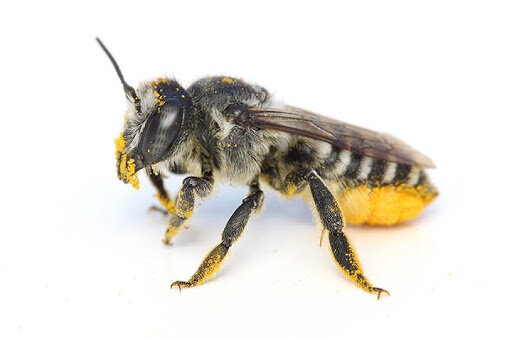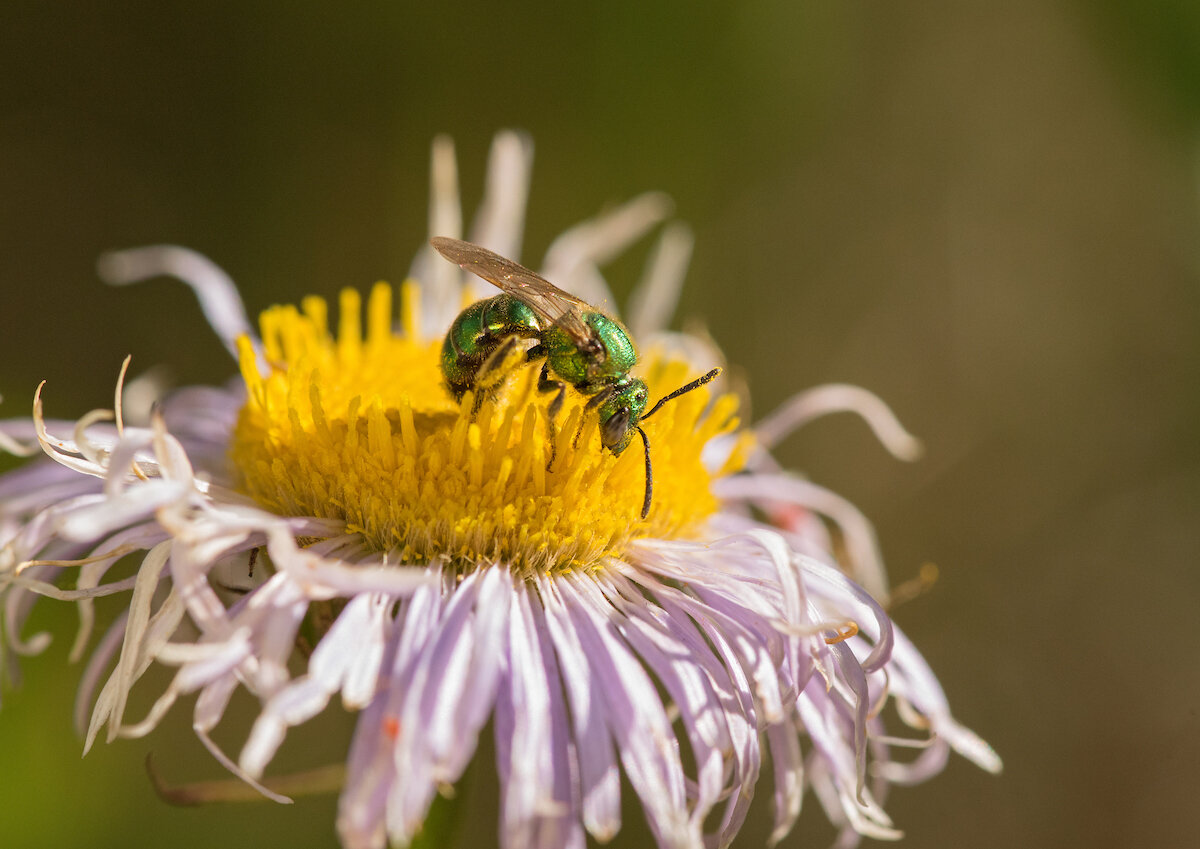A Gallery of Bees
To provide forage and nesting support for bees, learn the varieties of bees and their needs. This gallery provides a broad and incomplete overview of the varied species. (Scientific terms are defined the first time they are used.)
If you are interested in learning more about identifying bees, we recommend I Spy! Who's Using My Garden? by Katy Pye. This practical step-by-step workbook combines tools with a roadmap to help you identify and track which pollinators work in your garden now and after changes and which plants and other features are most important to them.
I Spy! Who's Using My Garden? is a great partner for your favorite pollinator identification guide. For California bees, we recommend Field Guide to the Common Bees of California by Gretchen LeBuhn and Noel B. Pugh.
Bee Families
Bees are classified as a monophyletic group (from one ancestor) within the superfamily Apoidea, which includes some wasps. Over 20,000 named species of bees are in seven biological families.
Andrenidae
Over 2,000 species, known as mining bees, found nearly worldwide particularly in temperate or arid areas; solitary, ground-nesters.
Apidae
Nearly 6,000 species, includes bumble bees, honey bees, stingless bees, carpenter bees, also parasitic cuckoo bees; some found worldwide, stingless bees in South America and Australia; honey bees spread worldwide by humans; many social, or eusocial (highest level of insect organization, with reproductive castes, specialized tasks and cooperative care of the young), most are cavity dwellers.
Colletidae
Over 2,000 species, known as plasterer bees for lining their nests with secretions that waterproof the walls; primarily found in South America and Australia, most are solitary ground nesters, some above ground nesters.
Halictidae
Over 2,000 species, called sweat bees as some are attracted to perspiration, many are metallic in appearance, some are green; found worldwide; most nest underground; most are solitary, some communal, semi-social or eusocial.
Megachilidae
Over 4,000 species, commonly named by materials they use in their nests: mason bees, leafcutter bees, carder bees, who use soil, leaves, and fibers, respectively, includes several species of parasitic cuckoo bees; found worldwide, mostly solitary, above ground nesters.
Melittidae
More than 200 species, with oligolectic foraging habits (specializing in a single genus of flowering plants, or more narrowly in a single species), found primarily in Africa; solitary, ground nesters.
Stenotritidae
Only 21 species restricted to Australia; ground nesting.
Social Bees
10% of bee species are social.
Honey Bees Apis mellifera
Photo© Clay Bolt / claybolt.com
Honey bees Apis mellifera (Apidae)
Seven Honeybee species include domesticated and feral European Honey Bees, spread worldwide by humans for honey and wax production and pollination of crops. They are eusocial, the highest level of organization, a single hive contains at least 40,000-45,000 bees. Many are far larger.
Stingless Bees Meliponini. Tanzania.
Photo by Muhammad Mahdi Karim - Own work, GFDL 1.2, https://commons.wikimedia.org/w/index.php?curid=6414865
Stingless Bees Meliponini (Apidae)
Native to tropical and subtropical regions of the world. Traditionally and still kept in Central America and Australia for their honey, which is significantly different from that of apis mellifera.
Queen yellow-faced Bumble Bee
(Bombus vosnesenskii)
San Francisco, California
Photo © Clay Bolt / claybolt.com
Yellow-faced Bumble Bee
Photo © Clay Bolt / claybolt.com
Bumble Bees Bombus
Live mostly in temperate climates of the Americas and Eurasia. Many bumble bees live in small colonies of only several dozen in which only the queen overwinters. Due to their size and style of pollination, they are efficient at pollinating plants many other bees cannot, for example rhododendrons and azaleas. Bumble bees are among the most endangered bees in North America and worldwide.
Solitary Bees
90% of bee species are solitary.
Many solitary bees are stingless
Every female is fertile and makes her own nest
No worker bees exist for solitary species
They do not produce either honey or beeswax
Above Ground Nesting Bees
About 30% of North American native bees nest Above Ground in wood tunnels or hollow stems.
Mason Bee (Osmia sp.)
Cody, Nebraska, Sandhill, Ryan Sexton
Northern Great Plains
Photo © Clay Bolt / claybolt.com
Mason Bees Osmia (Megachilidae)
140 species native to North America, 200 species worldwide
Mason bees gather mud to build their nests.
They nest in narrow gaps, or hollow stems or holes in wood made by wood-boring insects.
Several species are commercially propagated as an alternative or addition to honey bees.
More efficient pollinators than honey bees: 250 female osmia lignaria will pollinate an acre of apples, which would need up to two honey bee hives, with 15,000 to 20,000 workers in each (Bosch and Kemp, 2001).
Manufactured mason bee nest
Writer Katy Pye photographed this bee hotel in a Paris park.
The nesting habits of mason bees make them one of the easiest bee species to cultivate and care for on a small or large scale.
Leafcutter Bees Megachile
Leafcutter Bees Megachile (Megachilidae)
3,000 species native to Eurasia and North America.
Existing-cavity nesters.
These bees cut pieces of leaf or flower petals and use them to build their nests.
North America has many native Megachile species
Alfalfa leafcutter bees were introduced to the U.S. in the 1930s due to a decline in alfalfa seed production.One alfalfa leafcutter bee can do the job of 20 Honey bees (US Agricultural Research Service).
Alfalfa Leafcutter bees are being bred to supplement Honey bee pollination services.
Leafcutter next. Photo courtesy of Katy Pye.
Carpenter Bees Xylocopa
Carpenter Bees Xylocopa (Apidae)
These bees make their nests by boring holes in wood—they prefer rotten and unpainted, soft woods. So, leave some rotting wood in your yard and they won’t bother about your house.
Many people want to get rid of these bees if they discover they have them, however, they cause cosmetic damage more often than structural damage.
Like other species, they will sting only if provoked. Males cannot sting. However, they are territorial, and may fly at you, but they cannot harm you in any way.
The females are able to sting, but like bumble bees they are docile, and rarely do so. Their sting is described as like a mosquito bite.
Ground Nesting Bees
70% of North American native bee species are Ground Nesting Bees.
Mining bee, Caliopsis, female
Photo © Clay Bolt / claybolt.com
Mining Bees Andrena (Andrenidae)
1300 species, nearly worldwide.
Andrena are often oligolectic, meaning they collect pollen only from a select few plant species.
Some Andrena species are monolectic, meaning they collect pollen from only one species of plant. If that plant becomes rare or extinct, so does its pollinator.
Typical miner bee nests may consist of one small, main tunnel, with 5 or more branches, each containing an egg cell. The nests do not cause any damage in soil or gardens.
Photo © Clay Bolt / claybolt.com
Sunflower bee, Svastra obliqua (Apidae)
The sunflower bee (Svastra Obliqua) is a commonly found bee across much of North America. Like other members of its genus [Apidae], it is a very fast flying bee that zips to flower to flower, collecting pollen on its highly plumed back legs.
While introduced European bees often get much of the credit for pollination services in North America, species such as the sunflower bee are often as effective, if not more effective pollinators in many cases.
Unfortunately, the loss of intact and healthy grassland habitat throughout places such as South Dakota, where this individual was found, is having an impact on native bee populations.
— Clay Bolt
Sweat bee, Halictus sp, South Dakota
Photo © Clay Bolt / claybolt.com
Metallic green sweat bee (Augochloropsis sp), Bozeman, Montana
Photo © Clay Bolt / claybolt.com
Sweat Bees Halictidae
1,000 species in North America, occur worldwide.
Halictids are a diverse bee group, mostly generalists, meaning they visit a wide range of flowers.
Most halictids nest underground
The species has the most diverse gradation in social behavior as varying species are solitary, communal, semi-social or eusocial.Halictidae are one of the rare bee families that contain some nocturnal species, and species active only at dusk or in the early evening.













